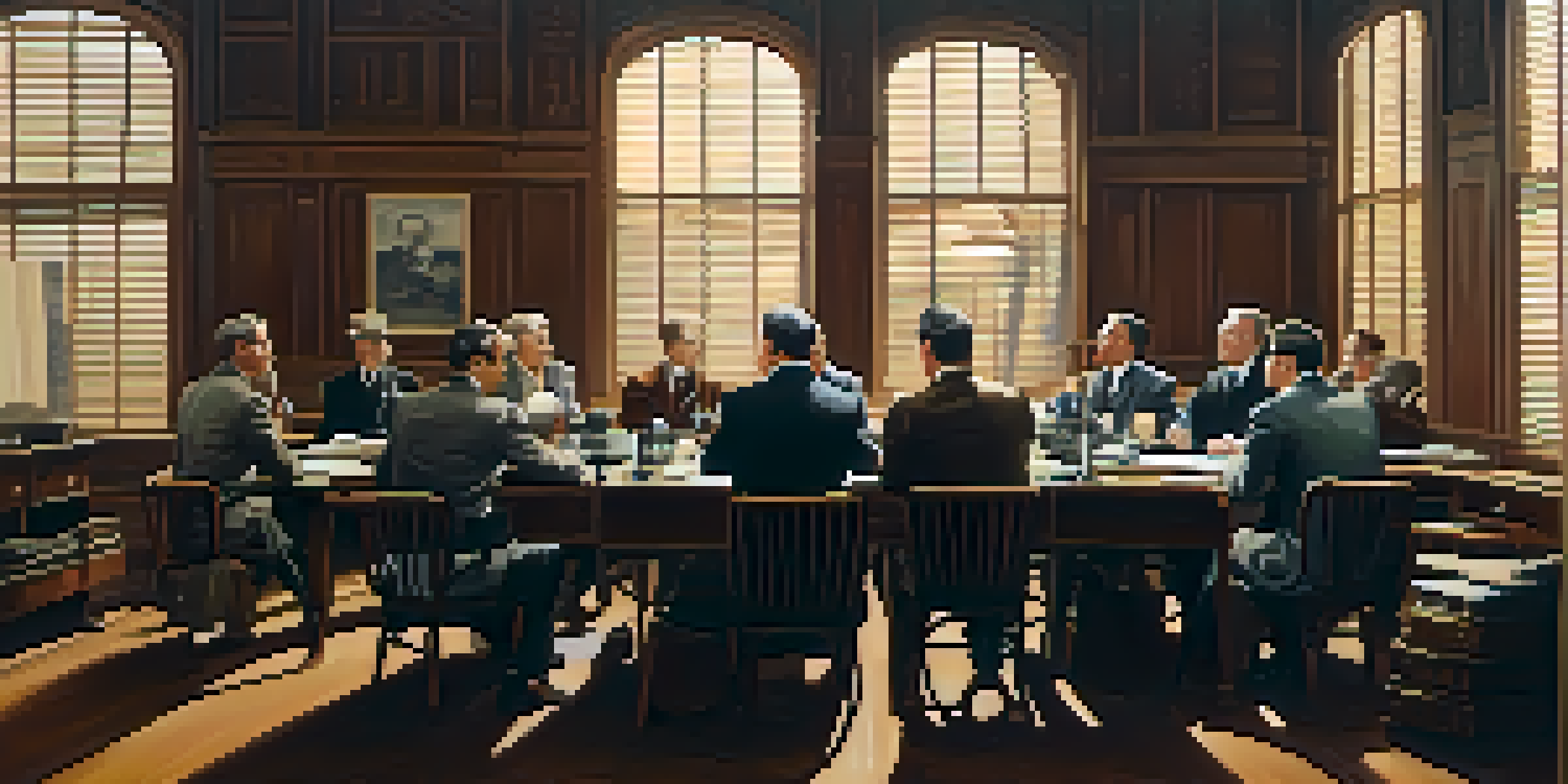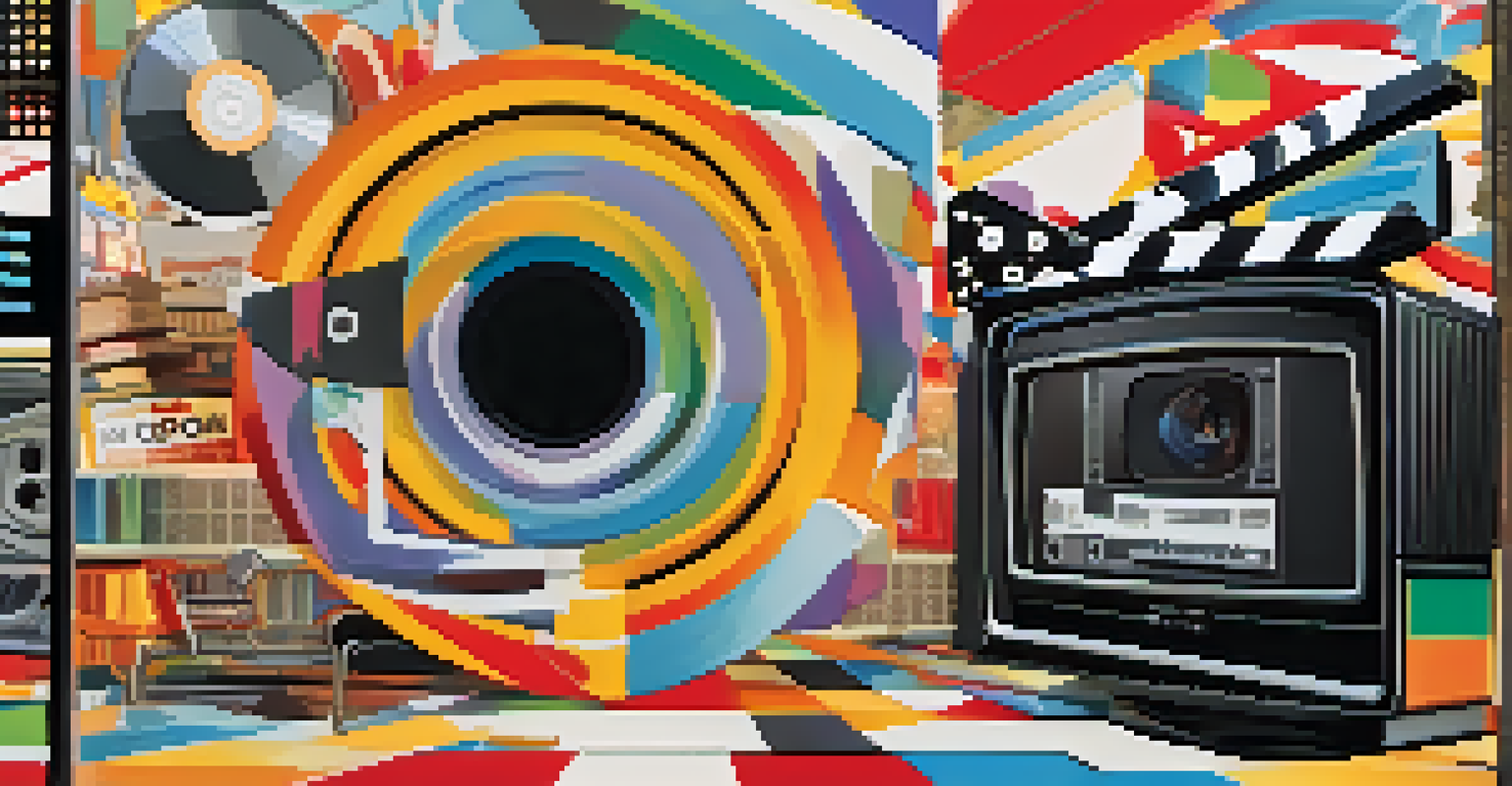The Role of Television in Shaping Film Censorship Norms

The Historical Context of Film Censorship
Film censorship has a rich history, often reflecting societal values and concerns. In the early 20th century, films faced strict scrutiny to uphold moral standards, which frequently led to the establishment of censorship boards. These boards aimed to protect audiences, particularly children, from perceived harmful content, setting the stage for ongoing debates around creative expression and community standards.
Censorship reflects a society's lack of confidence in itself. It is a hallmark of an authoritarian regime.
As television emerged in the mid-20th century, it brought new challenges and considerations to the table. With its widespread reach, television became a medium through which cultural norms were both reflected and challenged. This shift prompted a reevaluation of what content was deemed acceptable for films, as audiences became more accustomed to viewing diverse narratives on their screens at home.
The interplay between film and television has continued to evolve, illustrating how each medium influences the other. As television began to tackle more controversial topics, it began to push the boundaries of what was acceptable in film. This ongoing dialogue between the two forms of entertainment laid the groundwork for the contemporary landscape of film censorship.
Television's Role in Normalizing Content
Television has played a critical role in normalizing various themes that were once considered taboo in film. For instance, issues like mental health, LGBTQ+ representation, and racial diversity have found significant platforms on TV. As viewers became more comfortable with these topics on television, it inevitably influenced the types of stories filmmakers felt empowered to explore in their work.

Over the years, popular television series have tackled complex subjects with a level of nuance that often exceeds that of films. This has shifted audience expectations and, as a result, the standards for film content. Audiences now anticipate a level of authenticity and representation in films that mirrors their experiences, pushing filmmakers to consider longer-standing cultural narratives.
Television's Influence on Film Censorship
Television has reshaped film censorship by normalizing previously taboo subjects, allowing filmmakers to explore diverse narratives.
Moreover, the success of groundbreaking TV shows has encouraged filmmakers to take creative risks that were previously unthinkable. By showcasing diverse characters and storylines with depth, television has paved the way for more expansive narratives in cinema, which in turn affects how censorship boards evaluate film content.
The Influence of Ratings Systems
Television's ratings systems have become a powerful tool in shaping film censorship norms. The introduction of the TV Parental Guidelines in the 1990s provided a framework for categorizing content based on age-appropriateness. This system not only informed parents but also influenced filmmakers and studios in how they approached sensitive topics.
The function of censorship is to keep the public from knowing what the public does not want to know.
As film and television ratings became more standardized, filmmakers began to adjust their content to fit these evolving norms. The desire to appeal to broader audiences led to a more cautious approach to sensitive themes in films, with studios often choosing to tone down content to avoid restrictive ratings. This shift illustrates how television's regulatory frameworks have a direct impact on film production.
Furthermore, the distinction between 'family-friendly' and 'adult' content has become increasingly blurred, complicating the censorship landscape. As television shows aimed at adults continue to push boundaries, films are also challenged to keep pace, further affecting how censorship is approached. This dynamic creates a complex relationship between the two mediums, each influencing the other's content guidelines.
Cultural Influence and Audience Expectations
Cultural shifts often start on television, where social issues are explored in real time. As audiences engage with these narratives, their expectations for films evolve as well. When television portrays challenging topics authentically, it raises the bar for films, creating a ripple effect that influences censorship discussions.
For example, shows like 'The Handmaid's Tale' have sparked conversations about women's rights and authoritarianism, themes that ripple into films. Audiences who consume this content on television often seek similar depth and complexity in their cinematic experiences. This demand compels studios to navigate censorship with a more progressive mindset.
Ratings Systems Shape Content Norms
The evolution of television's ratings systems has influenced filmmakers to adjust their content to meet changing audience expectations.
The result is a more nuanced understanding of censorship, where film creators must strike a balance between artistic vision and audience expectations. This ongoing dialogue not only reshapes how films are produced but also challenges censorship boards to adapt to changing cultural landscapes, making their roles more dynamic.
Television as a Censorship Counterbalance
While television has contributed to evolving censorship norms, it also serves as a counterbalance to censorship itself. The rise of streaming platforms has drastically changed how audiences consume content, allowing for greater creative freedom. As viewers gravitate towards less regulated environments, traditional censorship practices are challenged.
This shift has led to a surge of independent films and series that confront censorship norms head-on. Creators are emboldened to tell their stories without the constraints of traditional film censorship, often using television as a platform to push boundaries. This dynamic creates a space for diverse voices that might otherwise be silenced in mainstream cinema.
Moreover, the dialogue between censorship and creative expression is becoming increasingly complex. As television continues to explore controversial and provocative topics, it encourages filmmakers to follow suit, fostering a culture where censorship is continuously reassessed. This relationship highlights the ongoing tension between regulation and creativity in both mediums.
Case Studies: Impactful Television Shows
Several television shows have made significant impacts on film censorship norms, serving as prime examples of this dynamic relationship. For instance, shows like 'Orange is the New Black' not only tackled issues of race and sexuality but also created conversations around the portrayal of women in media. Such narratives have influenced filmmakers to reevaluate their own storytelling approaches, resulting in a broader range of representations in cinema.
Another example is 'Breaking Bad,' which pushed the envelope in its depiction of morality and crime. This series challenged the notion of the anti-hero in a way that prompted filmmakers to explore darker themes without fearing backlash. As audiences embraced these complex characters, the boundaries of acceptable content in film expanded, reshaping censorship practices.
Censorship and Creative Expression
The rise of streaming platforms challenges traditional censorship, fostering a culture where filmmakers can explore unconventional themes.
These case studies highlight that television is not merely a companion to film but a powerful catalyst for change. As audiences engage with these groundbreaking shows, they bring their expectations to the cinema, thereby shaping what is deemed acceptable and worthy of exploration in film narratives.
The Future of Television and Film Censorship
Looking forward, the relationship between television and film censorship is poised to evolve even further. With the rise of digital streaming, audiences now have unprecedented access to diverse content, challenging traditional censorship norms. This accessibility encourages creators to push boundaries, requiring censorship bodies to adapt to new realities.
Additionally, as global audiences become more interconnected, cultural norms are beginning to shift on an international scale. Films and television shows that resonate across cultures may prompt a reevaluation of what is acceptable content, creating a more fluid understanding of censorship. The influence of global narratives will likely shape local censorship practices, fostering a richer tapestry of storytelling.

Ultimately, the future of censorship in both television and film will depend on audience engagement and societal values. As viewers demand authenticity and representation, both mediums must navigate this landscape thoughtfully. This continuous dialogue will not only redefine censorship standards but also enrich the storytelling experience for all.